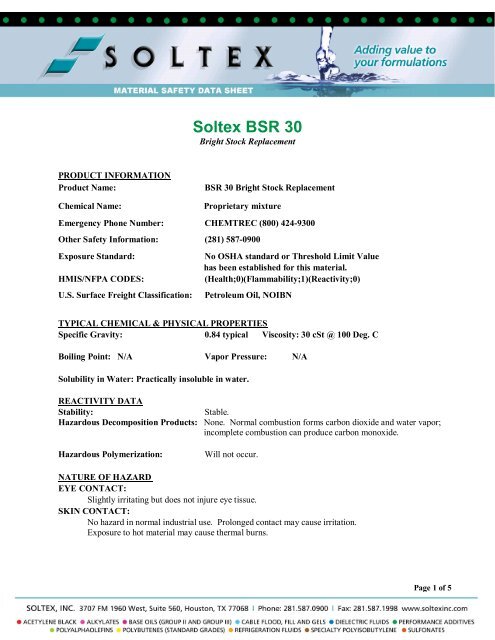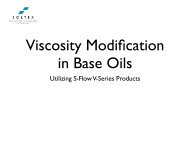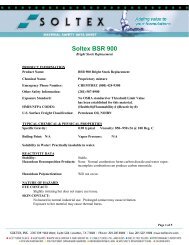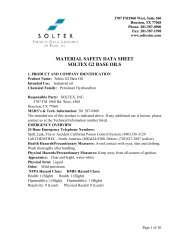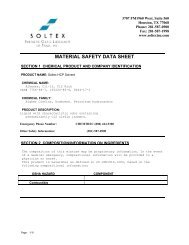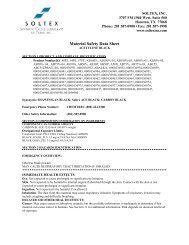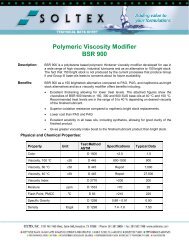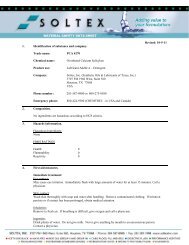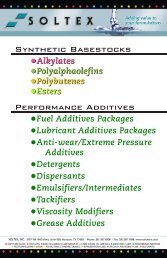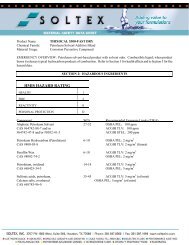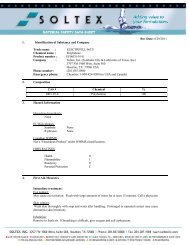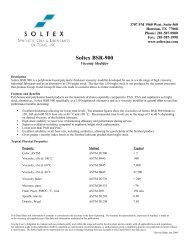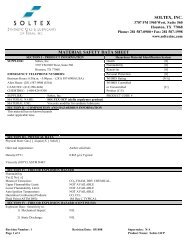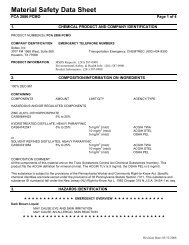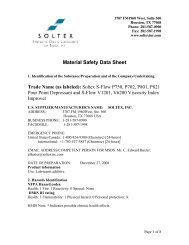Soltex BSR 30
Soltex BSR 30
Soltex BSR 30
Create successful ePaper yourself
Turn your PDF publications into a flip-book with our unique Google optimized e-Paper software.
<strong>Soltex</strong> <strong>BSR</strong> <strong>30</strong><br />
Bright Stock Replacement<br />
PRODUCT INFORMATION<br />
Product Name:<br />
<strong>BSR</strong> <strong>30</strong> Bright Stock Replacement<br />
Chemical Name:<br />
Proprietary mixture<br />
Emergency Phone Number: CHEMTREC (800) 424-9<strong>30</strong>0<br />
Other Safety Information: (281) 587-0900<br />
Exposure Standard:<br />
No OSHA standard or Threshold Limit Value<br />
has been established for this material.<br />
HMIS/NFPA CODES:<br />
(Health;0)(Flammability;1)(Reactivity;0)<br />
U.S. Surface Freight Classification: Petroleum Oil, NOIBN<br />
TYPICAL CHEMICAL & PHYSICAL PROPERTIES<br />
Specific Gravity: 0.84 typical Viscosity: <strong>30</strong> cSt @ 100 Deg. C<br />
Boiling Point: N/A Vapor Pressure: N/A<br />
Solubility in Water: Practically insoluble in water.<br />
REACTIVITY DATA<br />
Stability:<br />
Stable.<br />
Hazardous Decomposition Products: None. Normal combustion forms carbon dioxide and water vapor;<br />
incomplete combustion can produce carbon monoxide.<br />
Hazardous Polymerization:<br />
Will not occur.<br />
NATURE OF HAZARD<br />
EYE CONTACT:<br />
Slightly irritating but does not injure eye tissue.<br />
SKIN CONTACT:<br />
No hazard in normal industrial use. Prolonged contact may cause irritation.<br />
Exposure to hot material may cause thermal burns.<br />
Page 1 of 5
HEALTH INFORMATION & PROTECTION<br />
INHALATION:<br />
Negligible hazard at ambient (-18 to 38 Deg. C; 0 to 100 Deg. F) or recommended blending<br />
temperature.<br />
Avoid breathing vapors or mists.<br />
INGESTION:<br />
Minimal toxicity. Give water. Do not induce vomiting.<br />
FIRST AID<br />
EYE CONTACT:<br />
Flush eyes with large amounts of water until irritation subsides. If irritation persists, get medical<br />
attention.<br />
INHALATION:<br />
Use proper respiratory protection, immediately remove the affected victim from exposure. Administer<br />
artificial respiration if breathing is stopped. Keep at rest. Call for prompt medical attention.<br />
INGESTION:<br />
First aid is normally not required.<br />
WORKPLACE EXPOSURE LIMITS<br />
THE FOLLOWING OCCUPATIONAL EXPOSURE LIMITS ARE RECOMMENDED:<br />
Due to the oil-based components of this mixture, if misting occurs, control of exposure to 5mg/m3 or<br />
less is recommended.<br />
PRECAUTIONS<br />
PERSONAL PROTECTION:<br />
For open systems where contact is unlikely, wear safety glasses with side shields.<br />
Where contact may occur, wear safety goggles or face shield.<br />
Where contact may occur with hot materials, wear thermal resistant gloves, arm<br />
protection and a face shield.<br />
Where concentrations in air may exceed the limits given in this section and engineering,<br />
work practice or other means of exposure reduction are not adequate, NIOSH/MSHA<br />
approved respirators may be necessary to prevent overexposure by inhalation.<br />
VENTILATION:<br />
The use of mechanical dilution ventilation is recommended whenever this product is used in confined<br />
space, is heated above ambient temperatures, or is agitated.<br />
Page 2 of 5
FIRE AND EXPLOSION DATA<br />
Flash Point:<br />
Flammable Limits:<br />
Extinguishing Media:<br />
Fire Fighting:<br />
>190 Deg. C<br />
N/A<br />
CO2, Dry Chemical, Foam, or any Class B agent.<br />
Firefighters or others exposed to vapors or products of combustion<br />
should wear full protective clothing and self-contained breathing<br />
apparatus. Thoroughly decontaminate equipment after use.<br />
STORAGE AND ENVIRONMENTAL PROTECTION<br />
STORAGE REQUIREMENTS:<br />
No special requirements<br />
SPILLS AND LEAKS:<br />
Remove mechanically or contain on an absorbent material. Treat as an oil spill.<br />
WASTE DISPOSAL:<br />
Disposal must be in accordance with applicable federal, state, or local regulations. Determine waste<br />
classification at time of disposal. Conditions of use may render the spent product a hazardous waste.<br />
Enclosed-controlled incineration is recommended unless directed otherwise by applicable ordinances.<br />
EMPTY CONTAINERS:<br />
The container for this product can present explosion or fire hazards, even when emptied. To avoid<br />
risk of injury, do not cut, puncture, or weld on or near this container. Since the emptied containers<br />
retain product residue, follow label warnings even after container is emptied.<br />
TRANSPORTATION INFORMATION<br />
U.S. DEPT OF TRANSPORTATION<br />
If shipped above 212 F:<br />
Shipping Name<br />
Elevated Temperature Liquid, N.O.S.<br />
Hazard Class 9<br />
Identification Number UN3257<br />
Packing Group<br />
III<br />
If shipped below 212 F:<br />
Not regulated by DOT<br />
Page 3 of 5
INTERNATIONAL TRANSPORTATION INFORMATION:<br />
Sea (IMO/IMDG)<br />
If shipped above 212 F:<br />
Shipping Name Elevated Temperature Liquid, N.O.S.<br />
Class 9<br />
Packing Group III<br />
UN Number UN3257<br />
If shipped below 212 F:<br />
Not regulated<br />
Air (ICAO/IATA)<br />
Shipping Name Not regulated for non-bulk shipments only, Bulk shipment prohibited.<br />
European Road/Rail (ADR/RID)<br />
Shipping Name Not Regulated.<br />
Canadian Transportation of Dangerous Goods<br />
If shipped above 212 F:<br />
Shipping Name Elevated Temperature Liquid, N.O.S.<br />
Hazard Class 9<br />
UN Number UN3257<br />
Packing Group III<br />
If shipped below 212 F:<br />
Not regulated<br />
REGULATORY INFORMATION<br />
TSCA Status:<br />
This product is listed on the TSCA inventory.<br />
DOT Hazard Class/ID Number:<br />
Not applicable.<br />
CERCLA SECTIONS 102a/103 HAZARDOUS SUBSTANCES (40 CFR Part <strong>30</strong>2.4): This product is not<br />
reportable under 40 CFR Part <strong>30</strong>2.4.<br />
Page 4 of 5
SARA TITLE III SECTION <strong>30</strong>2 EXTREMELY HAZARDOUS SUBSTANCES (40 CFR Part 355):<br />
This product is not regulated under Section <strong>30</strong>2 of SARA and 40 CFR Part 355.<br />
SARA TITLE III SECTIONS 311/312 HAZARDOUS CATEGORIZATION (40 CFR Part 370): This<br />
product is not regulated under SARA Title III Section 311/312.<br />
SARA TITLE III SECTION 313 (40 CFR Part 372): This product is not regulated under Section 313 of<br />
SARA and 40 CFR Part 372.<br />
U.S. INVENTORY (TSCA): Listed on inventory.<br />
OSHA HAZARD COMMUNICATION STANDARD: Not hazardous per 29 CFR 1910.1200(d).<br />
WHMIS Controlled Product Classification: Not a Controlled Product under Canada's Workplace<br />
Hazardous Material Information System.<br />
EC INVENTORY (EINECS/ELINCS): In compliance.<br />
JAPAN INVENTORY (ENCS): Listed on inventory.<br />
AUSTRALIA INVENTORY (AICS): Listed on inventory.<br />
KOREA INVENTORY (ECL): Listed on inventory.<br />
CANADA INVENTORY (DSL): All of the components of this product are listed on the DSL.<br />
PHILIPPINE INVENTORY (PICCS): Not determined.<br />
No warranties, express or implied, including warranties of merchantability or fitness for a particular use are made with respect to the<br />
products described herein. Nothing contained herein shall constitute permission or a recommendation or inducement to practice any<br />
invention covered by a patent without the permission of the patent owner. Customers/users are advised to test the product in advance to<br />
make certain it is suitable for their particular production conditions and use or uses of the product. Seller shall not be liable for and the<br />
customer assumes all risk and liability for any use or handling of the product. Date: 08/26/11<br />
Page 5 of 5


